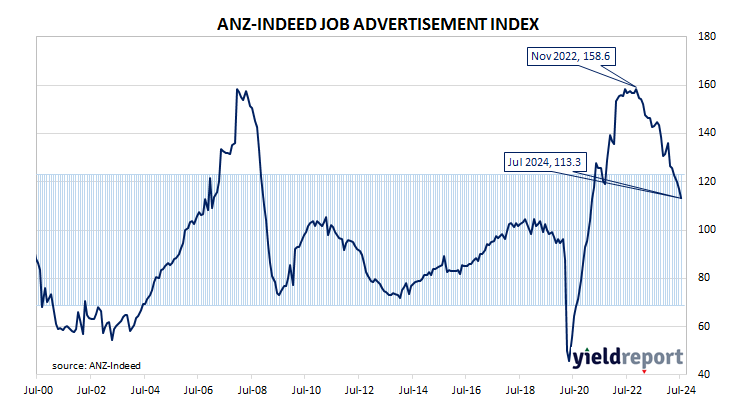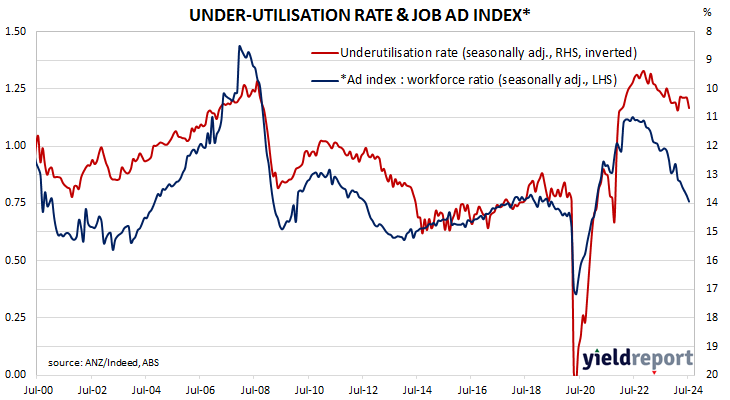Summary: Job ads down 3.0% in July; 20.8% lower than July 2023; ANZ: sixth consecutive monthly decline; ACGB yields generally rise; rate-cut expectations soften; ANZ: risk labour market could slow more sharply than forecast; ad index-to-workforce ratio declines.
From mid-2017 onwards, year-on-year growth rates in the total number of Australian job advertisements consistently exceeded 10%. That was until mid-2018 when the annual growth rate fell back markedly. 2019 was notable for its reduced employment advertising and this trend continued into the first quarter of 2020. Advertising then plunged in April and May of 2020 as pandemic restrictions took effect but recovered quite quickly, reaching historically-high levels in 2022.
According to the latest reading of the ANZ-Indeed Job Ads Index, total job advertisements in July decreased by 3.0% on a seasonally adjusted basis. The index fell from 116.8 in June to 113.3, with the loss following falls of 2.7% in June and 2.1% in May. On a 12-month basis, total job advertisements were 20.8% lower than in July 2023, down from June’s revised figure of -18.0%.
“ANZ-Indeed Australian Job Ads recorded its sixth consecutive monthly decline in July, with the series down 16.7% since January,” said ANZ economist Madeline Dunk. “This points to continued cooling in the labour market.”
Government bond yields generally moved higher on the day, mostly reversing the previous day’s plunge. By the close of business, the 3-year ACGB yield had gained 29bps to 3.60%, the 10-year yield had added 16bps to 4.03% while the 20-year yield finished 5bps lower at 4.41%.
Expectations regarding rate cuts in the next twelve months softened, although a February 2025 rate cut is still priced in. In the cash futures market, contracts implied an average of 4.315% in September, 4.29% in October and 4.195% in November. February 2025 contracts implied 4.04% while August 2025 implied 3.665%, 67bps less than the current cash rate.
“We’ve also seen the share of employers recruiting fall sharply in June to levels last seen during the east coast 2021 lockdowns, while average hours worked per employed person has declined 30 minutes a week since February 2023,” Dunk added. “Taken together, there is a risk the labour market could slow more sharply than we and the RBA are forecasting.”
The inverse relationship between job advertisements and the unemployment rate or the underemployment rate has been quite strong (see below chart), although ANZ themselves called the relationship between the series into question in early 2019.
A higher job advertisement index as a proportion of the labour force is suggestive of lower unemployment rates in the near future while a lower ratio suggests higher unemployment rates will follow. July’s ad index-to-workforce ratio declined from 0.78 to 0.76.
In 2008/2009, advertisements plummeted and Australia’s unemployment rate jumped from 4% to nearly 6% over a period of 15 months. When a more dramatic fall in advertisements took place in April 2020, the unemployment rate responded much more quickly.



